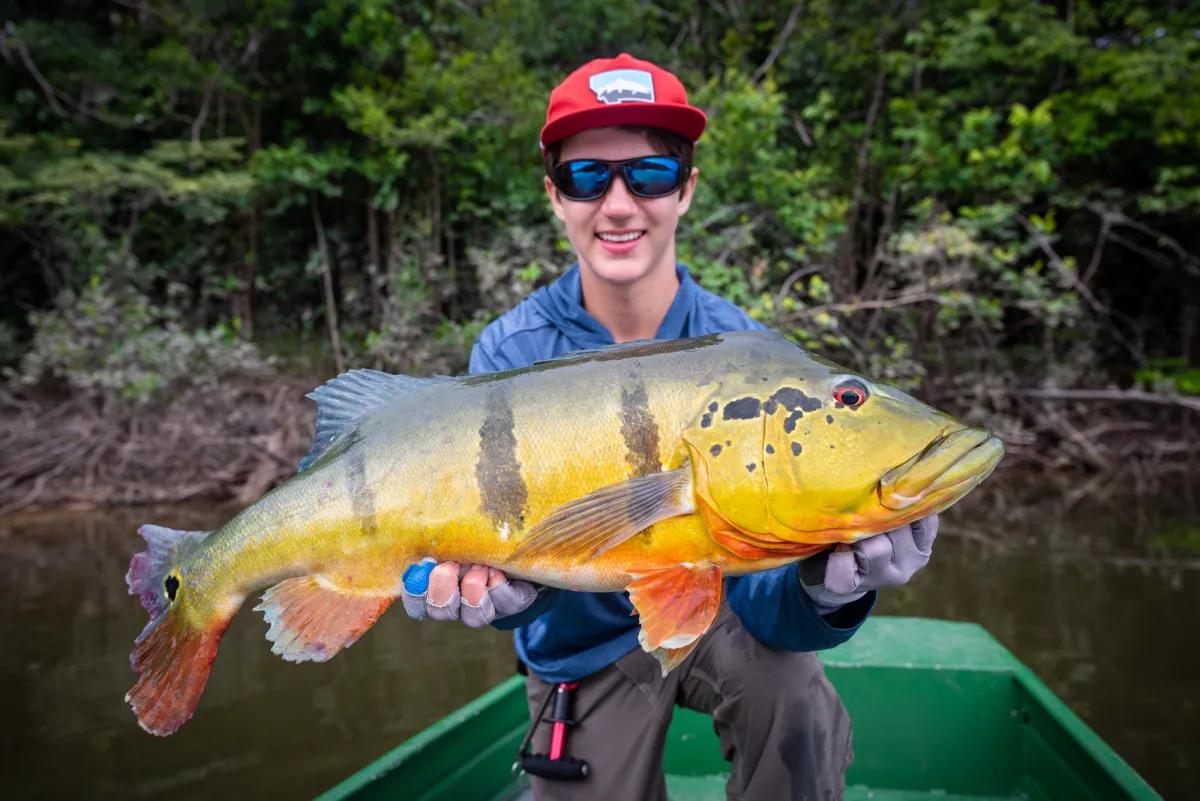
Our recent visit to Agua Boa Lodge in Brazil was nothing short of spectacular. Once the fly fishing travel bug takes hold, the adventuring angler will soon be faced with the difficult choice between exploring new places and returning to special destinations. Despite the vast angling destinations that planet earth and the brevity of our time to explore it all – there are some venues that simply demand revisiting. Such is the case of the remote fisheries of the Amazon River system. With over 3000 fish species, no other freshwater system in the world compares to the biological diversity of the Amazon drainage. There are more species of catfish in the Amazon (over 500) than all the combined fish species in North America. It should come as no surprise that some of these species provide for some exceptional sport fishing opportunities. The peacock bass reigns supreme as the most sought after sportfish in the Amazon. There are several species of this large member of the cichlid family with the temensis variety ruling as the largest and most prized. Temensis and other peacock species should be on every travelling angler’s bucket list. They offer everything that we prize in a sportfish: large size, spectacular beauty, explosive takes and tackle busting fights.
Although peacock bass can be found in multiple countries across the Amazon drainage, only a small handful of fisheries offer clear water sight casting opportunities. The Agua Boa River in Brazil’s Amazonas state is a clear water river that is unparalleled in the quality of experience. The Agua Boa offers just about everything you can ask for – great numbers, huge fish, explosive takes, a remote setting and spectacular wildlife.

The Fishery
What makes the Agua Boa river so unique is the clarity of the water. Most rivers in Brazil are either “black water” rivers or “white water” rivers. Black water rivers such as the Rio Negro and many of its tributaries have dark tannin stained waters. Although there is a low sediment load in black water rivers, the dark tannin stained water makes sight casting a challenge unless waters are very shallow over a sand bottom. White water rivers carry a heavy sediment load with very low visibility, so much of the fishing on traditional peacock bass waters is blind fishing around structure. The Agua Boa has excellent clarity and few tannins which allows for superb sight fishing opportunities during the dry season. While blind casting in some of the deeper waters is still an option, sight casting to cruising fish is also a great option. The quality of the sight fishing opportunities is truly what sets the Agua Boa in a class of its own.

Three species of peacock bass are found in the Agua Boa: temensis, butterflies and towa. Temensis are the largest variety and most sought after. Temensis can grow very large in the Amazon, with trophy sizes over 20lbs possible. Most of the temensis we landed on the Agua Boa were over 5lbs with 10-20lb fish caught every day of the trip. Temensis come in two color varieties – the barred “acu” and the spotted “paca”. Temensis tend to hunt in small groups. Some of the largest cruise as singles and doubles although we encountered numerous groups of 3-5 fish over 15lbs hunting together. Temensis will both cruise flats when actively hunting or rest in either deep water or near structure.
The smaller butterfly and towa species are also exceptional game species. Both varieties tend to be found in larger schools. Smaller fish in the 1-3lb range will often hunt in groups of 20-50 fish and orient around structure. Larger butterflies and towa in the 5-6lbs range group in size classes but in smaller groups of 2-10 fish.
The Agua Boa is also home to a variety of other gamefish including arapaima (the world’s largest scaled freshwater fish), arowana, payara (the “vampire” fish), piranha, jacunda, biracuda, dog fish, wolf fish, and several catfish species. Part of the allure of fishing jungle rivers is sampling the many unique species that call these waters home.
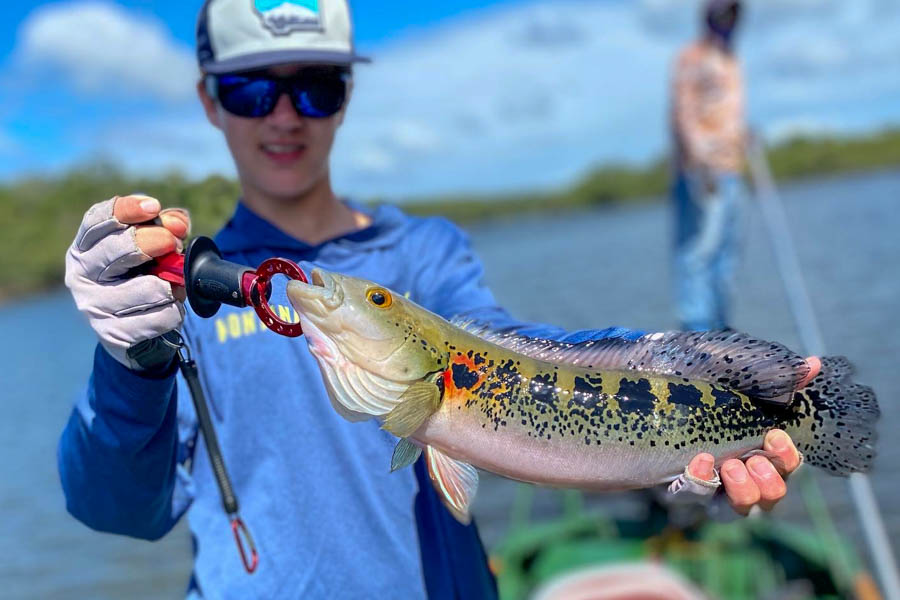
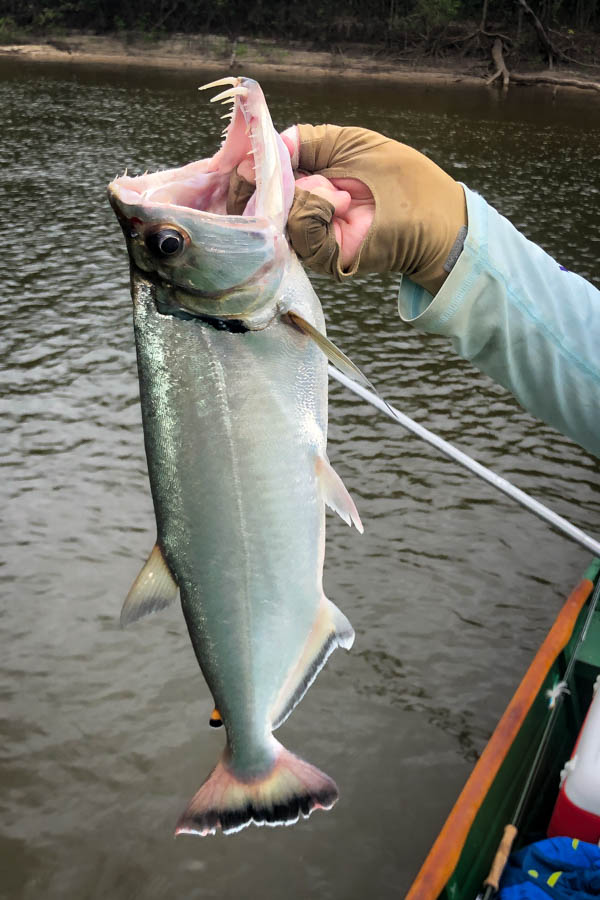

The Fishing Program
During a lodge week anglers can look forward to 7 days of fishing. The charter flight from Manaus arrives at the lodge around 8am. After a late breakfast and dropping gear off at your cabin, the guides are ready to set out for a day of fishing. The guides at Agua Boa are local Brazilians that grew up on the waters of the Amazon. Most of the guides have been with the lodge for many years and have an excellent knowledge of the main river and its many lagunas and adjacent oxbow lakes.
Fishing is conducted from aluminum skiffs retrofitted with poling platforms. These lightweight crafts are ideal for accessing hard to get to waters while providing a steady casting surface for anglers. There is a front deck and mid deck on each boat which allows two anglers to fish at the same time. Although lean bars for the front platform are an option most anglers bypass them. The boats are powered by either 30-horse prop outboard engines or 40-horse jets depending on water levels. The river is broken up into a variety of beats that each guide operates. Anglers rotate to new beats with a new guide each day. Each beat is approximately 10 miles of river and the guides on each beat have an intimate knowledge of where the fish are moving in each section as well as which waters have been rested. The river corridor also has numerous large back bays where the river backs up as well as a variety of lagunas. The lagunas are old river channels that are connected to the main river during the wet season but are often isolated during the dry season. Some lagunas can be accessed through small connecting channels to the main river (often with the help of a chainsaw or machete). On other lagunas smaller boats are left while anglers and guides hike in from the main river.


Fishing Techniques and Equipment
In Amazon fisheries a good mantra might be “eat or be eaten”. The Agua Boa is simply alive with fish. At lunch if you toss a piece of bread into the water there are generally hundreds of fish eaten it within seconds. At any given time the shallows of the main river or the back bays of a laguna are prone to erupt in explosions of water as peacock bass chase smaller bait fish. Even the largest peacock bass are potential prey for marauding freshwater dolphins, massive caiman, or the Amazonian giant river otter. In this environment flies that imitate a fleeing baitfish rule supreme.
We fished three different rigs depending on the type of water. 8 and 9 weight rods are preferred. I tended to gravitate to my 9 weight most often for some extra heft launching large flies and also the backbone to fight large fish. When fishing deeper back bays a heavy 300 grain, 25’ long sink tip is useful. The 7 inch per second sink rate on these lines help flies get deep fast. The most common rig we fished most days for streamers was a clear tip intermediate sink tip. This is a very versatile line that can be used for deeper water by letting the line sink for a few seconds before stripping, but also still useful for shallow sight casting. Finally a floating line is a nice option for throwing surface patterns like gurglers and poppers.
Streamers rule the fly selection. It is important to have a variety of sizes. The guides prefer to fish smaller flies on the skinny sand flats where fish are spooky and larger patterns for the deeper back bays. Most flies have some vivid colors so some oranges, yellows and chartreuse patterns work well. Peacocks are also prone to feed on smaller peacocks so multicolored peacock bass imitations can also work well. Doll eyes seem to really be important on streamer patterns – large eyes are often preferred. We tended to spend most of our time fishing more streamlined patterns such as mushies and large deceivers. Some of the higher profile patterns offer too much wind resistance to repetitively cast all day. Hook size is very important and you want large hooks. A 4/0 or 5/0 hook is best when targeting big fish. The larger hooks help to increase your hook up percentage on larger bass.
When peacocks are cruising in waters less than 4 feet deep (which they often are), surface patterns can be just as effective as streamers. I tended to have the best luck fishing gurglers. Poppers can also produce some explosive strikes but the fish tend to miss them more vs. the lower floating gurgler patterns that are popular for tarpon and stripers.
Anglers need to be ready to strip set hard when big bass hit. These are aggressive fish and once you see a fish is following it is best to strip even faster to trigger an explosive eat. Once the fish hits they can often miss so continuing to aggressively strip is important as often the fish will hit a second or third time. Once the line is tight with some aggressive strip setting hitting the fish with a strong rod hookset at a low angle to the water often seals the deal (similar to tarpon fishing).


Fishing the Lagunas
Most of the guide beats along the Agua Boa corridor have one or more lagunas near the river. These oxbow lakes are flooded each year during the wet season only to become cutoff from the main river during the dry season. Some lagunas still have a small connecting channel that allows the skiffs to access the lagunas while others are completely cut off. On the fully isolated lagunas the guides have stashed extra skiffs that can be accessed after a short hike through the jungle. These lagunas tend to have exceptional clarity as even the finest sediments have settled out. Each laguna has its own personality with some offering shallow sight casting to butterflies and medium sized temensis while others harboring huge trophy peacocks. The lagunas are also the primary locations to find the massive arapaima. On two different days we found few massive arapaima rolling and cruising in lagunas. Arapaima frequently grow to over 200lbs. These ancient fish are prone to roll at the surface in a similar fashion to tarpon. When a fish of this size surfaces it is more reminiscent of a sea monster than a game fish. A few lucky anglers each season hook up and occasionally land arapaima. Although they are rarely the sole angling target, when they make an appearance, you tend to drop everything and make some casts. The lagunas are also a favorite haunt for huge caiman. On most days our fishing would attract the interest of these big relatives of crocodiles. We frequently had large 15 foot caiman following our boat casually and sometimes swimming below us hoping to intercept a peacock bass. On two occasion we had the unnerving experience of having large caiman charge our skiffs until we quickly released a bass. Occasionally the guides would use their poles to pop the caiman a few times to discourage them from any grand ideas.
Over the course of the week we fished about 6 different lagunas. Many of them are simply boiling with fish as packs of butterflies coral baitfish into the shallows or a small group of hunting temensis erupt at the waters surface. In general the lagunas tend to produce fast action and high catch rates. Several of them also had some very large temensis (we had several in our party land fish in the 15-17lb class out of lagunas). I split time between fishing surface patterns on a floating line in the shallower flats of the lagunas with using a count down sinking line approach when fish were deeper. Half of the fun of fishing the lagunas is getting to them. Watching the guides brandish machetes and at times chainsaws to hack a path for the boats through the jungle is always an adventure.




Hunting Big Fish in Backwater River Bays
The Northeastern Amazon basin is at a low elevation and its rivers have a slow gradient as a result. There are many large backwater bays along the Agua Boa. These bays are often a half a mile long and are often home to some huge peacock bass. These back bays also tend to be where the legendary freshwater porpoises and dolphins of the Amazon are encountered. On multiple days we had either the smaller grey porpoises or the larger pink dolphin rolling and feeding behind our boat while we fished. On one occasion a grey porpoise caught us by surprise and tried to intercept a peacock as we released it. Luckily the bass was still energetic and made a rapid areal flight to the bank with 8 foot leaps at a time out of the water to avoid the predator.
Although groups of smaller butterflies could be found in the cover of the downed trees along the banks – the larger temensis often patrolled in slightly deeper water. Generally on the large bays blind casting sink tips produced about two thirds of the big fish opportunities. While fishing it was also important to scan the water as often some actively hunting temensis could be located and then cast to. On some days these back bays would produce just a few shots at big fish while on other days they were red hot. On our final fishing day we landed over 25 temensis including 17 fish over 10lbs and 5 fish over 15 lbs – all from just 2 of these large back bays.



Sight Casting on the Sand Flats
Without a doubt, my favorite waters to fish were the expansive sand flats along the main river. During the rainy season sands are carried down the river and form extensive underwater dune structures. These powder white sand structures produce some exceptional site casting opportunities. Anytime the sun was high we welcomed opportunities to pole these flats hunting for big fish. Fish counts on these flats are lower than in the lagunas and back bays. When fish are found they are often spooky due to the shallow waters and required long and accurate casts close enough so the flies would garner the attention of the bass, but not so close that they were lined. The challenges of these flats generated much lower catch rates than some of the other waters but the quality was exceptional. Words really can’t describe the rush of spotting a 10lb plus peacock at a distance and then watching it accelerate on your fly from 10 feet away. On these flats I had as much success on surface patterns as I did on subsurface streamers. The gurglers worked exceptionally well and stripping them as fast as possible was the ticket. The violent takes when a big bass would crush these rapidly stripped surface patterns is one of the coolest fly fishing experiences that I have had the good fortune to enjoy in my fly fishing career.

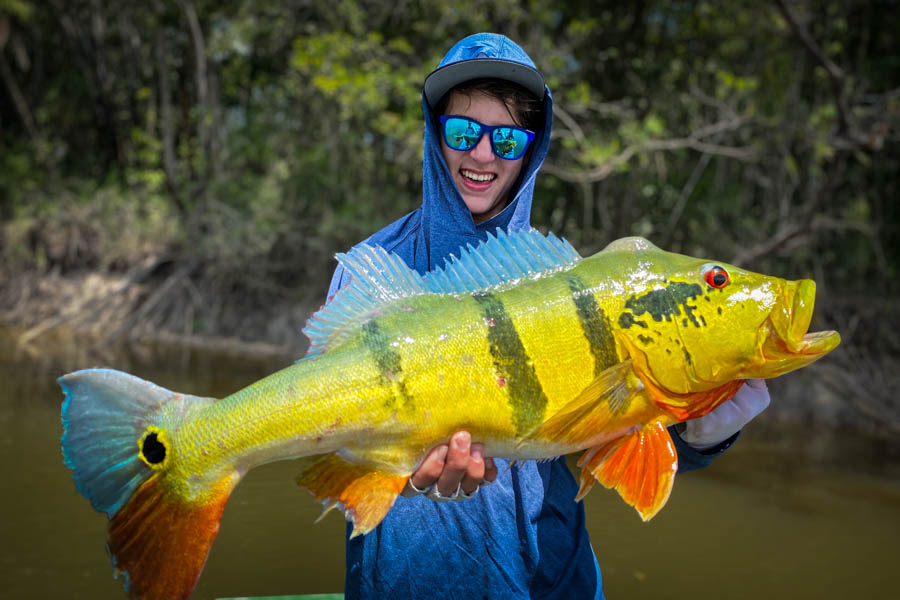
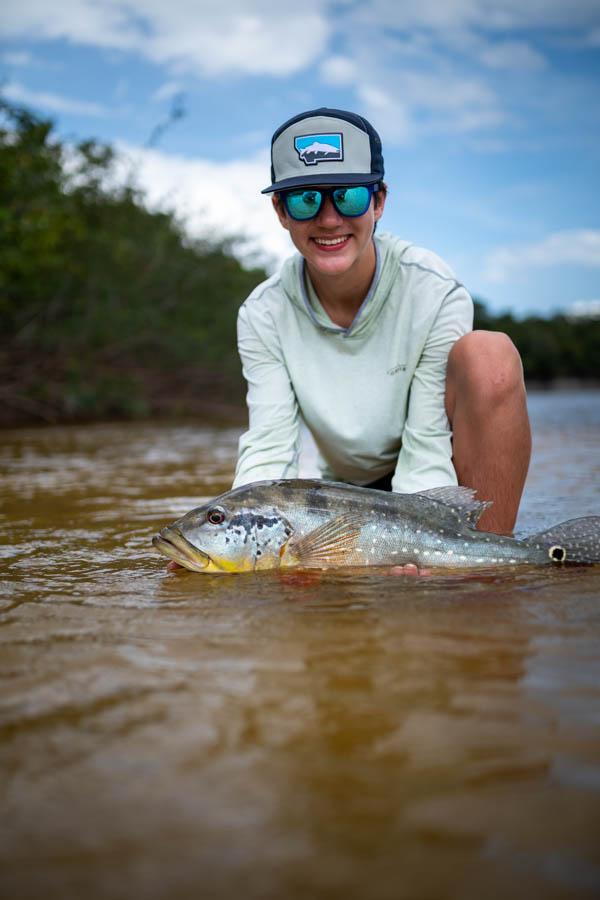

Amazon Wildlife
The icing on the cake on a trip to this remote region in the Amazon is the spectacular intact rainforest ecosystem that you are immersed in. The lodge is in the heart of the vast Amazon wilderness. Upon leaving the gateway city of Manaus on a Cessna Caravan – you spend nearly 2 hours flying over the vast and remote wilderness below. To be in a place this wild is humbling. There are no people to leave garbage, no planes in the air to generate noise, no roads for hundreds of miles. There is nothing but a vast and intense expanse of life. The sounds of the jungle are filled with the rumbling roars of howler monkeys, the squawking of macaws, the splashing of hunting otters and bass and the ever present cacophony of singing frogs and chirping insects. Jaguar prints are found on the white sand beaches, sloths and a variety of monkey species climb in the trees, dolphins patrol the river, caiman wait patiently on the beaches and birds of every shape, size and color are found nearly everywhere.





The Lodge
A more remote setting is difficult to imagine for a lodge location. In spite of the many challenges that such a remote location produces, the lodge and guest cabins are incredibly comfortable and well appointed. An asphalt air strip allows weekly Cessna flights to help resupply the lodge during the season. In the wet season larger supplies and building materials for repairs or renovation can be brought up from Manaus after several days journey by boat. There are six air conditioned guest cabins with 2 queen beds and hot showers. The main lodge has a large dining area, an equally large sitting area with satellite TV (we managed to watch some NFL playoff games one night along with a Brazilian National Soccer team game on another evening), and a game room with pool table and ping pong.
Dinners are buffet style each evening and offer many local favorites such as arapaima filets, piranha night, etc. The lodge manager (Carlos) and his staff have been with the lodge for years and everything runs like a well oiled machine.



Getting There
Most years American anglers can enjoy a direct flight from Miami to Manaus (5.5 hour flight) on American Airlines. During the pandemic this route was suspended although it is slated to return soon. For our recent trip our guests flew through either Sao Paolo or Rio De Janeiro. We generally recommend arriving into Manaus the day before travelling to the lodge. Once in Manaus, Lucio and his team help guests transfer from the airport to a local hotel. Lucio also is a great asset for arranging city tours or making reservations and provided transfers to local restaurants. The city tour of Manaus as well as visiting the floating villages on the Amazon river are a great addition to the trip. On this visit we also decided to add an extra day in Rio de Janeiro to enjoy some of the great beaches, some sight seeing and a Brazilian league soccer match.





Summary
Fishing the Amazon system really should be on every angler’s bucket list. There is no place on planet earth that can quite compare to the intensity of wildlife (both in the forest and in the river) that can be found in this vast wilderness. The Agua Boa fishery has something for everyone: high catch rates, high quality sight casting, big fish, and amazing wildlife in every direction. I would like to extend a huge thanks to Carlos, the guides, the lodge staff and Lucio’s crew back in Manaus for helping our group to enjoy an experience that is exceptionally unique.
